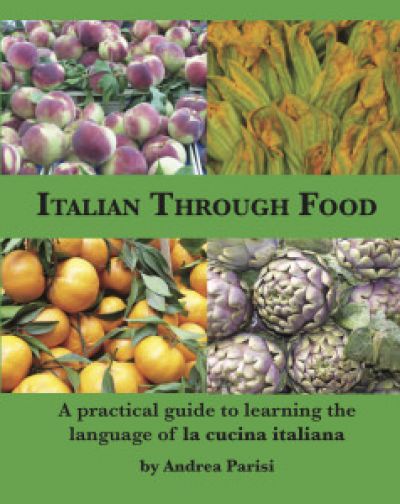One of the greatest cuisines in the world is Italian. It’s on all the “best” and “popular” food lists and, in America, Italian food tours of restaurants, specialty food shops and bakeries are offered in many large cities. In Italy, food is one of its most revered assets; most notably for the freshness of the ingredients and the simplicity of the recipes.
Speaking Italian is also an asset – whether to preserve Italian culture, for business purposes or to have an understanding of the language for a trip abroad. In addition to attending classes, many online versions are available, providing numerous options for study of the Italian language. But, what if you could learn about the traditions and history of Italy’s favorite foods and learn to speak Italian at the same time?
“Italian Through Food” is “a practical guide to learning the language of la cucina Italiana.” The material in the book started as a tutorial for an Italian language class, but author and instructor Andrea Parisi saw a greater need for the lesson plans and thought the “workbook would be useful for other teachers, giving them ideas and saving them time.”
Andrea was born in America, but in moving to Italy she “learned how to eat well.” Inspired by the food of Italy and seeing in her classes how in talking about food “students light up and really get engaged,” Andrea garnered feedback from her students and added color and images to her lesson plans to create an easy-to-follow workbook with visual appeal.
In the Introduction, Andrea notes that “by the end of this book, you’ll have built up a working vocabulary of 600 words and phrases” and “you’ll be able to apply your Italian language skills and cultural awareness in order to confidently interact with Italians in any … context in which food is the main subject.”
The book is divided into 20 units, preceded by two short, but extremely informative, chapters with some language basics – “Pronunciation Rules” and “Three Important Things Everyone Should Know About Italian Food Cultures and Languages,” where Andrea makes a special point, “There is no one-size-fits-all definition of la cucina Italiana.”
The units are grouped into sections and starting with “Basic Food Vocabulary,” Andrea ties in an overview of the history of Italian food and Italian food in America with the fundamentals of Italian language. In “Section 2: Adjectives, prepositions and specialized food vocabulary” are introduced through la pasta, la carne, il pane, formaggi e salumi, and il pesce with a side of “the names and corresponding adjectives for regions of Italy.”
Section three presents “Conversational skills for purchasing and ordering foods, where and when Italians eat.” Andrea explains, “Everyday life in Italy is punctuated by several pasti (meals) and snack breaks,” and she provides the time of day and corresponding meal, along with a chart of numbers in Italian “for planning and paying for your meals.” In this section, a list of the various food establishments in Italy are noted, along with details about il bar (the coffee bar), food boutiques, la pizzeria, la gelateria and il menu. Some regional variances are also included.
The last section, “Talking about taste and quality, recipes and food traditions,” covers vino e olio, tools and tastes, reading a recipe, sweets and holidays, and food trends in street food and slow food. The months, seasons and holidays are mentioned, along with some regional festivals.
Each unit builds on the one before it, expanding the learner’s Italian vocabulary and knowledge of Italian food. Tables and charts help to divide the material, breaking it into separate components that are easier to recognize. Each unit also has several exercises with space to write in the answers and a unit review to reinforce learning. As an added bonus: Andrea’s website provides study tools and the answers to the exercises.
On her website, it states, “Italian Through Food” is “designed for self-guided language learners, foodies who travel and Italian speakers looking for an enjoyable way to refresh their skills.” One caveat: This book will make you hungry; eat before you read.
The Italian American Press, an online source of books primarily written by authors of Italian heritage, offers a selection of books that cover every topic, all written with respect for Italian American and Italian culture, heritage and history. Many of the books listed provide a better understanding of Italian Americans and the immigrant experience is the foundation of Italian American culture.



